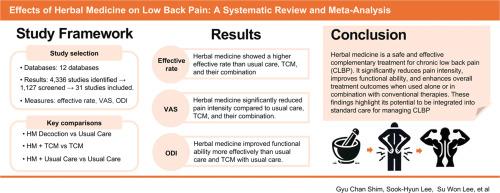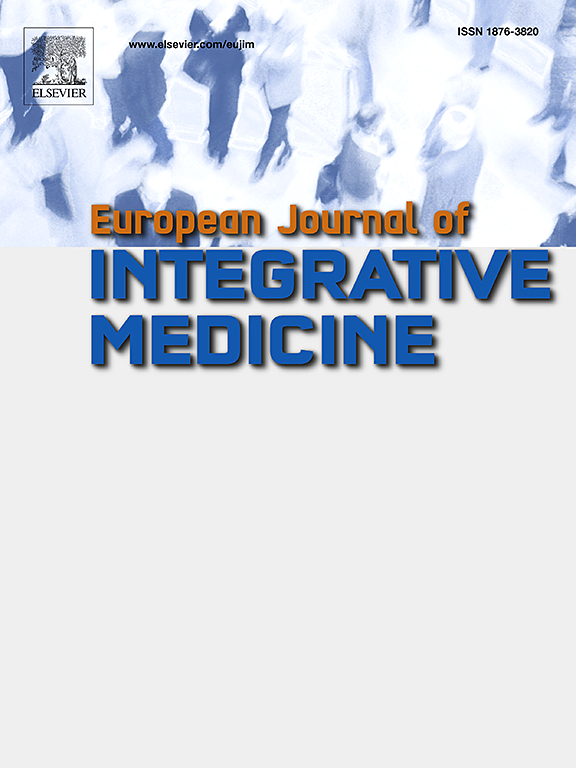东亚传统中药煎剂对腰痛的影响:系统回顾和荟萃分析
IF 1.7
4区 医学
Q3 INTEGRATIVE & COMPLEMENTARY MEDICINE
引用次数: 0
摘要
腰痛(LBP)是导致残疾和经济负担的主要原因。中药煎剂作为东亚传统医学(TEAM)的核心组成部分,其潜在的益处正受到人们的关注。本系统评价了HM煎剂治疗腰痛的疗效。方法该方案在PROSPERO注册(CRD42024599753)。检索11个数据库,检索2024年7月前发表的HM煎剂治疗LBP的随机对照试验(rct)。主要结果为临床改善率(CIR)和疼痛视觉模拟评分(VAS)。次要结果包括Oswestry残疾指数和日本骨科协会量表。使用Cochrane风险偏倚2工具和荟萃分析进行质量评估。结果纳入29项随机对照试验,共纳入2420名LBP患者。与非甾体抗炎药(NSAIDs)相比,HM汤改善了CIR(风险比[RR] 1.16, 95% CI: 1.05 ~ 1.29),减轻了VAS-pain(平均差异[MD] -0.87, 95% CI: -1.59 ~ -0.14)。与TEAM联合使用时,HM汤改善了CIR (RR, 1.23, 95% CI: 1.14 ~ 1.33)和VAS-pain (MD -1.24, 95% CI: -1.80 ~ -0.67)。与单用非甾体抗炎药相比,HM汤联合TEAM改善了CIR (RR 1.25, 95% CI: 1.01 ~ 1.55)和VAS-pain (MD -0.51, 95% CI: -0.67 ~ -0.34),且CIR (RR 1.30, 95% CI: 1.12 ~ 1.52)高于TEAM联用非甾体抗炎药。与单用非甾体抗炎药相比,HM汤联合非甾体抗炎药改善了CIR (RR 1.48, 95% CI: 1.19 ~ 1.85);然而,VAS-pain没有差异(MD -1.09, 95% CI: -2.35 ~ 0.17)。HM汤联合非药物治疗(NPTs)改善了CIR (RR 1.18, 95% CI: 1.05 ~ 1.32)和VAS-pain (MD -1.28, 95% CI: -1.42 ~ -1.14)。最后,在非甾体抗炎药和NPTs方案中加入HM汤也改善了CIR (RR 1.24, 95% CI: 1.09 ~ 1.42),但VAS-pain的降低无统计学意义(MD -1.53, 95% CI: -3.35 ~ -0.29)。在七个报告不良事件的随机对照试验中,这些不良事件在干预组和对照组之间没有或轻微,并且具有可比性。结论中药汤剂对腰痛患者有良好的临床疗效。局限性包括在许多随机对照试验中存在高偏倚风险。设计良好的随机对照试验可以验证其有效性。本文章由计算机程序翻译,如有差异,请以英文原文为准。

Effects of traditional east asian herbal medicine decoctions on low back pain: A systematic review and meta-analysis
Introduction
Low back pain (LBP) is a major cause of disability and economic burden. Herbal medicine (HM) decoctions, a core component of Traditional East Asian Medicine (TEAM), are gaining attention for their potential benefits. This systematic review evaluated HM decoctions for LBP.
Methods
The protocol was registered in PROSPERO (CRD42024599753). Eleven databases were searched for randomized controlled trials (RCTs) on HM decoctions for LBP published before July 2024. Primary outcomes were the clinical improvement rate (CIR) and visual analogue scale (VAS) for pain. Secondary outcomes included the Oswestry Disability Index and the Japanese Orthopedic Association scale. Quality assessments using the Cochrane Risk of Bias 2 tool and meta-analyses were conducted.
Results
Twenty-nine RCTs involving 2420 participants with LBP were included. HM decoction compared to Non-Steroidal Anti-Inflammatory Drugs (NSAIDs) improved the CIR (risk ratio [RR] 1.16, 95 %CI: 1.05 to 1.29) and reduced VAS-pain (mean difference [MD] -0.87, 95 %CI: -1.59 to -0.14). When combined with TEAM, HM decoction improved the CIR (RR, 1.23, 95 %CI: 1.14 to 1.33) and VAS-pain (MD -1.24, 95 %CI: -1.80 to -0.67) compared to TEAM alone. The combination of HM decoction and TEAM improved the CIR (RR 1.25, 95 %CI: 1.01 to 1.55) and VAS-pain (MD -0.51, 95 %CI: -0.67 to -0.34) compared to NSAIDs alone, and a higher CIR (RR 1.30, 95 %CI: 1.12 to 1.52) than TEAM combined with NSAIDs. Combining HM decoction with NSAIDs improved the CIR (RR 1.48, 95 %CI: 1.19 to 1.85) compared to NSAIDs alone; however, there was no difference in VAS-pain (MD -1.09, 95 %CI: -2.35 to 0.17). HM decoction combined with non-pharmacological therapies (NPTs) improved the CIR (RR 1.18, 95 %CI: 1.05 to 1.32) and VAS-pain (MD -1.28, 95 %CI: -1.42 to -1.14). Finally, adding HM decoction to a regimen of NSAIDs and NPTs also improved the CIR (RR 1.24, 95 %CI: 1.09 to 1.42, but the reduction in VAS-pain was not statistically significant (MD -1.53, 95 %CI: -3.35 to -0.29).. In the seven RCTs that reported adverse events, these were absent or mild and comparable across intervention and control groups.
Conclusion
HM decoction demonstrated beneficial clinical effects for participants with LBP. Limitations included high risk of bias in many RCTs. Well-designed RCTs are warranted to validate effectiveness.
求助全文
通过发布文献求助,成功后即可免费获取论文全文。
去求助
来源期刊

European Journal of Integrative Medicine
INTEGRATIVE & COMPLEMENTARY MEDICINE-
CiteScore
4.70
自引率
4.00%
发文量
102
审稿时长
33 days
期刊介绍:
The European Journal of Integrative Medicine (EuJIM) considers manuscripts from a wide range of complementary and integrative health care disciplines, with a particular focus on whole systems approaches, public health, self management and traditional medical systems. The journal strives to connect conventional medicine and evidence based complementary medicine. We encourage submissions reporting research with relevance for integrative clinical practice and interprofessional education.
EuJIM aims to be of interest to both conventional and integrative audiences, including healthcare practitioners, researchers, health care organisations, educationalists, and all those who seek objective and critical information on integrative medicine. To achieve this aim EuJIM provides an innovative international and interdisciplinary platform linking researchers and clinicians.
The journal focuses primarily on original research articles including systematic reviews, randomized controlled trials, other clinical studies, qualitative, observational and epidemiological studies. In addition we welcome short reviews, opinion articles and contributions relating to health services and policy, health economics and psychology.
 求助内容:
求助内容: 应助结果提醒方式:
应助结果提醒方式:


